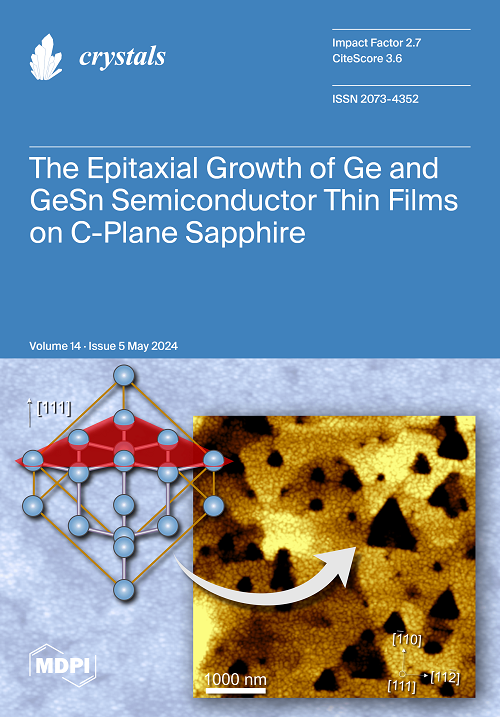Effect of Methylxanthines on Urate Crystallization: In Vitro Models of Gout and Renal Calculi
IF 2.4
4区 材料科学
Q2 CRYSTALLOGRAPHY
引用次数: 0
Abstract
Background: Common forms of pathological crystals are uric acid or urates, which are responsible for gout, urolithiasis, and other conditions. Methods: We used a kinetic–turbidimetric crystallization assay to evaluate the effect of ten specific methylxanthines on the crystallization of monosodium urate, potassium urate, and ammonium urate in conditions that mimicked urine. We also studied the effect of different levels of 7-methylxanthine in the presence of other biological compounds (albumin and hyaluronic acid) on the solubility of monosodium urate in conditions that mimicked synovial fluid. Results: The results showed that 7-methylxanthine in the range of 16.61–49.84 mg/L inhibited the crystallization of each urate when the initial urate concentration was 3 × 10−3 M (500 mg/L) and the conditions mimicked urine, and that the greatest inhibitory effect was for monosodium urate. In addition, 7-methylxanthine at a concentration of 25 mg/L totally prevented the crystallization of monosodium urate at an initial urate concentration of 2.38 × 10−3 M (400 mg/L) in conditions that mimicked synovial fluid. Moreover, at a low concentration of 7-methylxanthine, albumin and hyaluronic acid increased this inhibitory effect. Conclusions: Our in vitro results demonstrate that 7-methylxanthine inhibits the crystallization of urates in conditions that mimic synovial fluid and urine.甲基黄嘌呤对尿酸盐结晶的影响:痛风和肾结石的体外模型
背景:尿酸盐或尿酸盐是常见的病理性结晶,是痛风、泌尿系结石等疾病的罪魁祸首。方法我们使用动力学-比浊结晶测定法评估了十种特定甲基黄嘌呤在模拟尿液的条件下对尿酸单钠、尿酸钾和尿酸铵结晶的影响。我们还研究了在有其他生物化合物(白蛋白和透明质酸)存在的情况下,不同浓度的 7-甲基黄嘌呤在模拟滑液条件下对尿酸单钠溶解度的影响。结果显示结果表明,当初始尿酸盐浓度为3×10-3 M(500 mg/L)、模拟尿液的条件下,7-甲基黄嘌呤在16.61-49.84 mg/L范围内可抑制每种尿酸盐的结晶,其中对尿酸单钠的抑制作用最大。此外,在模拟滑膜液的条件下,当初始尿酸盐浓度为 2.38 × 10-3 M(400 mg/L)时,浓度为 25 mg/L 的 7-甲基黄嘌呤可完全阻止尿酸单钠结晶。此外,在低浓度的 7-甲基黄嘌呤中,白蛋白和透明质酸会增强这种抑制作用。结论:我们的体外实验结果表明,在模拟滑液和尿液的条件下,7-甲基黄嘌呤可抑制尿酸盐结晶。
本文章由计算机程序翻译,如有差异,请以英文原文为准。
求助全文
约1分钟内获得全文
求助全文
来源期刊

Crystals
CRYSTALLOGRAPHYMATERIALS SCIENCE, MULTIDIS-MATERIALS SCIENCE, MULTIDISCIPLINARY
CiteScore
4.20
自引率
11.10%
发文量
1527
审稿时长
16.12 days
期刊介绍:
Crystals (ISSN 2073-4352) is an open access journal that covers all aspects of crystalline material research. Crystals can act as a reference, and as a publication resource, to the community. It publishes reviews, regular research articles, and short communications. Our aim is to encourage scientists to publish their experimental and theoretical results in as much detail as possible. Therefore, there is no restriction on article length. Full experimental details must be provided to enable the results to be reproduced. Crystals provides a forum for the advancement of our understanding of the nucleation, growth, processing, and characterization of crystalline materials. Their mechanical, chemical, electronic, magnetic, and optical properties, and their diverse applications, are all considered to be of importance.
 求助内容:
求助内容: 应助结果提醒方式:
应助结果提醒方式:


